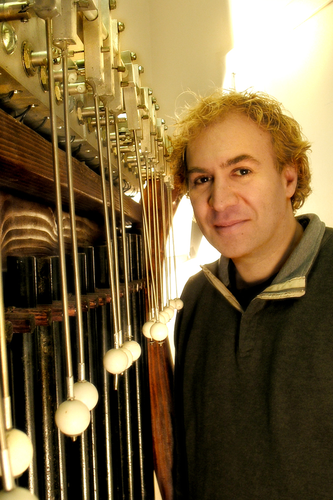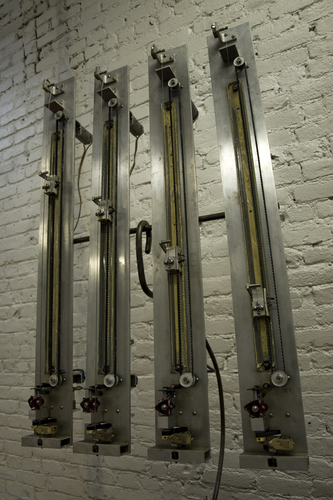Alumni Profile: Eric Singer '91
Founded in 2000, the League of Electronic Musical Urban Robots(Opens in a new window) (LEMUR) was born of Berklee alumnus Eric Singer's idea to create acoustic instruments that would function much the way that synthesizers do, in that they could be played from a computer. But the sound itself is all created live. Since then, LEMUR has worked with everyone from alternative rock band They Might Be Giants to new-music composer Jim Thirlwell, to computer music pioneer Mort Subotnick, to free improv jazz performer George Lewis, to contemporary violinists Mari Kimura and Todd Reynolds. LEMUR installations have been presented at museums around the country.
Outside of the group, the music synthesis major (now electronic production and design) has used his background in both music and computer science to create MIDItron(Opens in a new window), an electronic board that makes it easier for people to make alternative instruments, as well as Cyclops, software that generates sound through motion-tracking. The following is a condensed and edited account of our conversation.
Are the robotic instruments physically playable by humans?
One of the philosophies of the group is to create instruments from scratch instead of using existing instruments. To me, it's more interesting to create an instrument that is a robot than to create a human-playable instrument and make a robot to play it. I feel in most cases that humans are good at playing instruments designed for humans and robots are good at playing instruments designed for robots.
[LEMUR creation] GuitarBot is the best example of this. It doesn't look like a guitar, and until it starts to play you might not know that it's a robot or that it's a musical instrument. When people think of a robot they think of C3P0 or Robbie the Robot or something like that, so really "robot" is sort of tongue-in-cheek. It breaks people's expectations.
Do they sound like instruments that we're familiar with? Does the GuitarBot actually sound like a guitar?
It sounds like a warped version of a guitar. It's a slide guitar, and it has a little bit of a twang to it. In fact, it has four strings and each one is independent, so it's kind of like having four one-string slide guitar players at your beck and call. You can arrange for them however you want, without respect for whether the intervals would be playable by a human. It's about putting as much control into the hands of the performer/composer as if they were using synthesizers, but now they're using acoustic instruments.
Did you start LEMUR because you felt hemmed in by traditional instruments?
I see it as continuing the tradition of instrument-making. People always try to come up with new instruments, and now the tools for doing that are technology. Probably if I lived in the 16th century I would be creating different kinds of violins and harpsichords, but I live in the 21st century, so I'm making musical robots.
I had been creating nontraditional electronic instruments that humans play, like gloves and batons and a rubber tube that you bend, and the computer generates sound based on that. These things sort of challenge people's ideas of how you can create music. So I'd been making these instruments that were human-playable, and they'd send MIDI into a computer. They're input devices. I'd been doing that for a long time and I thought, "What if I turned that on its head and created MIDI output devices?"
I can put it in the hands of a layperson, and now they're able to create a little musical performance without having to learn a whole new difficult instrument, like the saxophone. So it put the musical experience into other people's hands, as well as being a very interesting performance interface for me, as the performer. You create a different kind of music than you would with a jazz quartet or something like that.
Are there other Berklee alumni in LEMUR?
There have been about a hundred people contributing to this over the years as apprentices, instrument builders, artists, and composers. Our latest project was creating most of the instruments for Pat Metheny for his Orchestrion(Opens in a new window) tour, a worldwide tour of him backed entirely by robotic musical instruments. There were probably 50 robotic musical instruments onstage, most of which were created by LEMUR. A lot of the concert is him performing works that he created specifically for this, and then at a certain point he starts improvising using his MIDI guitar to create parts for the instruments that he builds up in loops, and then he plays his guitar over that. So there is this live improvisation including the robots.
Do you create installations as well as performances?
We have an installation we've developed called LEMURtron. That is about 20 robotic instruments arrayed around a room, some of them hanging from the ceiling, some of them standing on the floor. In the middle of the room is a video projection, and there's a camera on the ceiling that tracks people moving through that projection. The projection shows different kinds of scenarios; one of them is kicking billiard balls around. Of course, they're video billiard balls, so we use the camera to track people's motions, and every time they kick a virtual ball, it'll send it rolling. And when it collides with another ball, it sets off a pair of robots playing that corresponds to the two balls. We're mostly placing it in children's museums and science museums, because kids love to run around, and they get to control all 20 instruments at once based on how they move around.
What Berklee professors have influenced you?
I was lucky enough to work with Richard Boulanger [professor, Electronic Production and Design] as an undergrad and as his assistant for several years. We traveled all around the world and did performances on nontraditional instruments, and they were very well received. Richard has always been a good friend, an amazing teacher, and an amazing collaborator. I honestly wouldn't be doing what I'm doing now if he hadn't shown me the path, and that path is very different than a lot of people learn in school. He taught me that there are other ways to make music than just straight-ahead learning your instrument and playing it. There are other kinds of new possibilities now because of technology.







